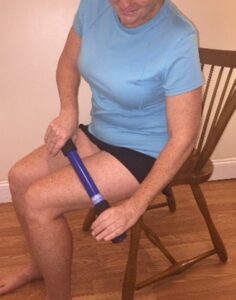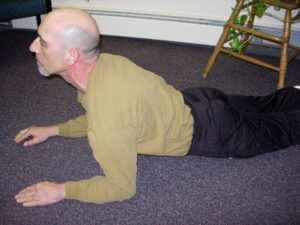Muscles, Nerves, And Restless Leg Syndrome
Author: Julie Donnelly, LMT –The Pain Relief Expert
Editor: Dr. Steve Chaney
Never-ending Summer
 It is starting to cool off in other parts of the country, but it’s still hot in Florida right now. Sometimes it feels like we have never-ending summer in Florida. Thank heaven for air conditioning!
It is starting to cool off in other parts of the country, but it’s still hot in Florida right now. Sometimes it feels like we have never-ending summer in Florida. Thank heaven for air conditioning!
For those of us who are old enough to remember the days before air conditioning, we are even more grateful for air conditioning. I remember being pregnant with my son in 1967, when we were living in San Antonio, Texas. Most people didn’t have air conditioning yet, and we certainly didn’t. I came to realize why Southerners talk so slow (remember, I’m a New Yorker). It was so hot we just didn’t talk at all. It took too much effort!
Fortunately, this time of year seems to pass quickly, and we’ll be getting back into cooler weather before we know it. At least, that’s what I’m telling myself.
Restless Leg Syndrome (RLS)
 A reader asked me to talk about RLS this month. Restless Leg Syndrome is a tricky topic, depending on which expert you read. The Mayo Clinic said there isn’t a known cause of RLS, but it may be caused by an imbalance of the brain chemical dopamine. The Mayo Clinic has also said RLS can be related to:
A reader asked me to talk about RLS this month. Restless Leg Syndrome is a tricky topic, depending on which expert you read. The Mayo Clinic said there isn’t a known cause of RLS, but it may be caused by an imbalance of the brain chemical dopamine. The Mayo Clinic has also said RLS can be related to:
- Peripheral neuropathy.
- Iron deficiency.
- Kidney failure.
- Spinal cord conditions.
Yes, there isn’t a definitive cause for RLS.
A friend had RLS and told me that when she took iron supplements, and totally avoided flour and sugar that her symptoms disappeared. Then I read that iron is the worst thing to take for RLS. Go figure!
In any case, I’m not a doctor or a nutritionist, so I look at the possible muscular cause of RLS.
Muscles, Nerves, And RLS
The nerves that go to your leg are the sciatic and femoral nerves, which are the continuation of your spinal cord, separating at your lumbar vertebrae to go down both of your legs.
The femoral nerve goes underneath and through your psoas muscle and under your inguinal ligament. It innervates your anterior/medial thigh muscles. The importance in this pathway will be discussed, but please make note of how the nerve passes underneath the inguinal ligament.
Your sciatic nerve is the largest nerve in the body. Its pathway is so big that we’ll just say it innervates your buttocks and the rest of your leg and foot that isn’t innervated by the femoral nerve.
After leaving your spine at your low back, these nerves pass under and through some powerful muscles, and this can be a problem when the muscles are tightened by a repetitive strain injury (RSI). When a muscle contracts it pulls on the insertion point and you move a joint.
As you do something over and over (something as simple as sitting down and staying still for a long period of time) a phenomenon called “muscle memory” causes the muscle to shorten to a contracted length, and you have a problem when you go to move in the opposite direction.
For Example…
Two muscles, the psoas and iliacus, connect your lumbar vertebrae and pelvis to your upper leg (femur). When they contract you bend forward (psoas), lift your leg (iliacus) or sit down (both muscles). When you sit for an extended period of time, muscle memory causes the muscles to change to the shorter length.
When you go to stand up these muscles are too short to easily lengthen enough for you to stand up, and you feel a strain at your low back. Both your lumbar vertebrae and your pelvis rotate forward and down as the muscles are being strained while they are lengthening.
As the pelvis is rotating forward and down, several things happen that impact the sciatic and femoral nerves.
First the muscles tighten and since the nerves are passing through the muscles, the nerves are “pinched” in the pelvic area. This can cause the nerves to send impulses to the lower leg and foot.
Next, as I mentioned above, the femoral nerve passes through the psoas muscle and is then directly underneath the inguinal ligament. As the muscle tightens it presses the nerve up into the inguinal ligament, causing potential damage to the nerve, and also sending impulses to the quadriceps muscles.
As these nerves are impinged and sending impulses to the muscles, the muscle fibers may respond with itching, burning, and twitching. You are experiencing the results in your thigh, but the cause of the problem is actually deep in your lower pelvic area.
[I realize this description is a bit confusing, and I’m not going into detail here. However if you are interested, or if you have low back pain, I suggest you consider getting my book The 15 Minute Back Pain Solution. This book will explain all of it in detail, and it will show you how to self-treat each muscle that impacts your low back, hips, sciatic nerve, groin, and knees.]
Relief From Restless Leg Syndrome
Most times the order of treatment isn’t important, but when it comes to the pelvic muscles, and all the related muscles, the order is vital as one muscle can stop the entire treatment protocol from working. This is why I wrote The 15 Minute Back Pain Solution. It gives you the exact order of treatment, and has photographs of doing each treatment, along with the explanation and a graphic of where that muscle refers pain/numbness. To try to explain it here would require my putting the book into a newsletter, so that isn’t doable.
 Start by treating your anterior thigh muscles. I’m going to show you how to treat just the anterior thigh muscles that can be impacting the femoral nerve.
Start by treating your anterior thigh muscles. I’m going to show you how to treat just the anterior thigh muscles that can be impacting the femoral nerve.
Use a piece of 1” x 12” PVC pipe to slide (not roll) down your thigh from the very top of your leg to your knee. Cover your entire anterior thigh and out toward the outside of your leg.
Press deeply, it should feel like “hurts so good,” not “I think I’m going to faint!” You are in control of the pressure so keep it at your tolerance level.
If you feel a bump, that’s a knot (spasm) that is pulling down on your pelvis. Just stop on it and roll back and forth, trying to break it up. Keep treating any knots you find in your thigh muscles.
A Good Stretch For Your Psoas Muscle
 Next stretch your psoas muscle. There is a yoga stretch that will help to stretch your psoas muscle, rotate your pelvis back into alignment, and take the pressure off both the sciatic and femoral nerves. The stretch is called the Sphinx.
Next stretch your psoas muscle. There is a yoga stretch that will help to stretch your psoas muscle, rotate your pelvis back into alignment, and take the pressure off both the sciatic and femoral nerves. The stretch is called the Sphinx.
Lie down with your pelvis firmly resting on the floor.
Put your bent elbows directly under your shoulders as shown in this picture.
Lean back, keeping your pelvis and elbows on the floor.
You are stretching the psoas muscle that is rotating your pelvis.
When you are comfortable doing this stretch, then you can do it standing up:
Put your calves up against the cabinet under your kitchen sink, and your butt gently pressing on the front of the sink. These must stay still, don’t change the pressure at all or you have moved your pelvis.
Pivot at your lumbar vertebrae, leaning back with your upper back, while keeping your head as shown in the picture.
If you feel increased or decreased pressure on your butt, you have moved your pelvis. Keep trying until you can lean back without moving your pelvis at all.
This is a start to treating the muscles that may be causing RLS. Since muscles are the one thing the medical profession doesn’t look at, there’s a good chance this will help you!
Wishing you well,
Julie Donnelly
These statements have not been evaluated by the Food and Drug Administration. This information is not intended to diagnose, treat, cure, or prevent any disease.
